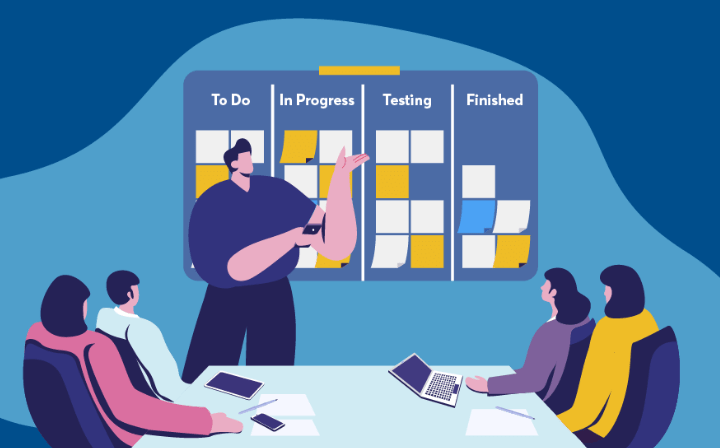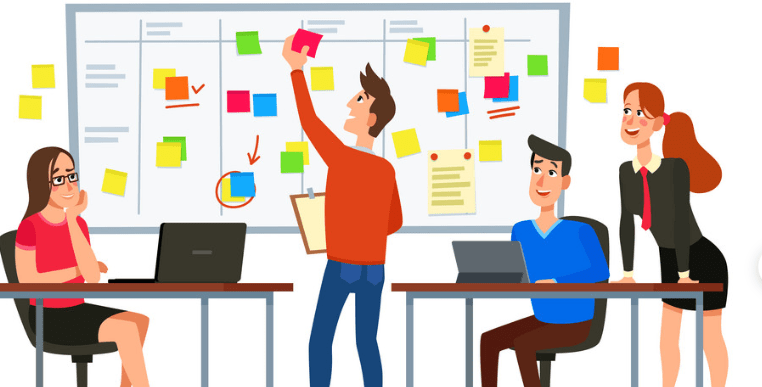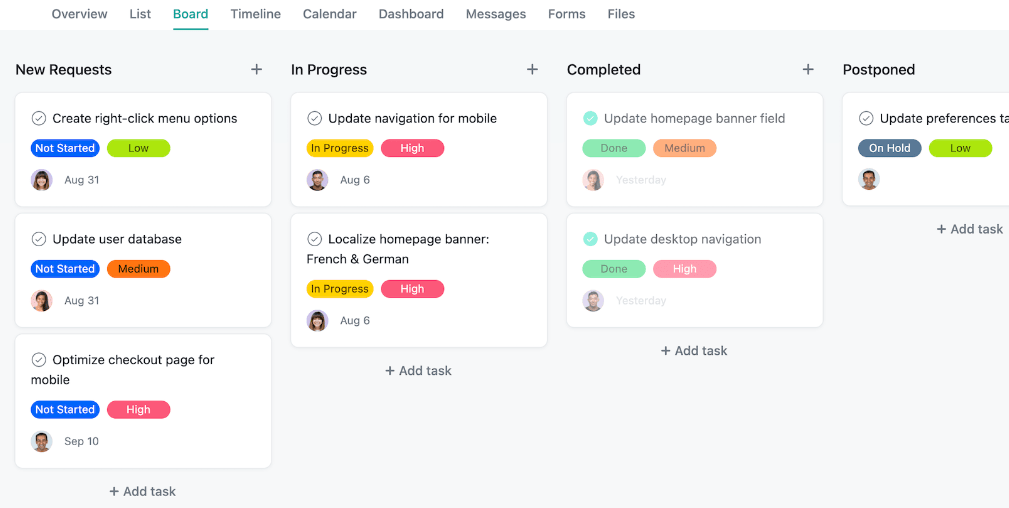Managing agile meetings may seem challenging, especially with multiple team members and tasks involved. Agile meetings are a crucial part of the agile development process, facilitating effective collaboration and communication within teams.
This article will provide you with an understanding of what agile meetings are – along with their benefits – and offer valuable tips on how to manage them effectively.
Key Takeaways
- Agile meetings are important for effective collaboration and communication in agile development.
- The main types of agile meetings include sprint planning, daily standups, sprint reviews, and retrospective meetings.
- The benefits of agile meetings include increased collaboration, improved productivity, and faster decision-making.
- To manage agile meetings effectively, focus on goals, encourage collaboration among team members, and utilize project management software.
Understanding Agile Meetings

Agile meetings are an essential part of the agile development process, involving team members coming together to collaborate and make decisions in order to efficiently deliver projects.
Definition
Agile meetings are key in agile development. They help team members talk to each other and work together. The aim of these meetings is to let everyone know about all parts of the project life cycle.
This way, they can make sure they are working on the same goal. There are four main types: sprint planning, daily standups, sprint reviews, and retrospective meetings. Sprint planning happens at the start of each cycle or “sprint”.
Here, they set tasks for the next sprint. Daily standups are quick daily updates from every member on their progress and any issues faced by them. At a sprint review which comes towards the end, teams check their work done so far and take feedback from others who hold stakes in it.
Then there’s a sprint retrospective where teams look back at how they did things before deciding what they need to do better next time.
Participants
In Agile meetings, all team members have a role to play. They talk and listen in turns. Project leaders, software developers, testers and others take part in these meetings. Sprint planning meetings are where they decide on goals for the next sprint.
The daily standup is a quick meeting each day. In it, each person says what they did yesterday and plan to do today. Also, they mention any problems they face. This helps the whole team stay updated.
Sprint review meetings happen at the end of sprints or work periods. Here, everyone reviews work done in the sprint just ended.
Lastly comes the Sprint retrospective meeting after each sprint ends. This is where teams look at how well or poorly they worked during that period and find ways to get better.
Types of Meetings (Sprint Planning, Daily Standup, Sprint Review, Sprint Retrospective, Backlog Refinement)
Agile meetings help teams work together. They create a plan and fix any problems.
| Meeting Type | Description |
|---|---|
| Sprint Planning Meetings | Teams set goals and tasks for the upcoming sprint. |
| Daily Standup Meetings | Daily team updates on progress, plans, and issues. |
| Sprint Review Meetings | Review completed work at the sprint’s end. |
| Sprint Retrospective Meetings | Post-sprint reflections for continuous improvement. |
| Backlog Refinement Meetings | Ordering unfinished work by its importance or value. |

Benefits of Agile Meetings
Agile meetings offer increased collaboration, improved productivity, and faster decision-making.
Increased collaboration
Agile meetings promote increased collaboration among team members. By bringing everyone together regularly, these meetings foster a sense of unity and shared responsibility. Through open discussions and updates on progress, team members can align their efforts towards common goals, exchange ideas, and solve problems collectively.
This collaborative environment encourages cross-functional communication and knowledge sharing, leading to an improved understanding of the project’s scope and requirements. As a result, teams can work more cohesively, leverage each other’s strengths, make informed decisions faster, and deliver high-quality results efficiently.
Improved productivity
Agile meetings can greatly improve productivity within a team. By bringing everyone together regularly, these meetings ensure that team members are all on the same page and have a clear understanding of project goals and tasks.
This alignment helps to minimize confusion and duplication of efforts, allowing the team to work more efficiently towards completing their objectives. Additionally, agile meetings encourage collaboration and open communication among team members, fostering a sense of shared responsibility for project success.
With increased collaboration and streamlined workflows, teams can accomplish tasks faster and with greater efficiency. This not only boosts productivity but also allows for quicker decision-making and problem-solving throughout the project life cycle.
Faster decision-making
In agile meetings, faster decision-making is a key benefit. With regular and focused discussions, team members can quickly address any issues or challenges that arise during the project.
By bringing together different perspectives and expertise, decisions can be made more efficiently, helping to keep the project on track. Agile meetings provide a platform for open communication and collaboration, allowing teams to make informed choices in a timely manner.
This ensures that the right decisions are made at the right time, promoting productivity and progress within the team.

Tips for Managing Agile Meetings
Focus on goals, encourage collaboration, and utilize available tools to ensure efficient and productive Agile meetings. Read more to discover how to manage your Agile meetings effectively.
Focus on goals
In agile meetings, it’s important to stay focused on the goals of the project. This means keeping everyone aligned and working towards the same objectives. By clearly defining and communicating the goals, team members can better understand their individual responsibilities and how they contribute to the overall success of the project.
Focusing on goals also helps teams prioritize tasks and make decisions that align with achieving those objectives. When everyone is working towards a common goal, it increases productivity, collaboration, and ensures efficient progress throughout the project life cycle.
Encourage collaboration
In agile meetings, it’s important to encourage collaboration among team members. By working together and sharing ideas, the team can come up with better solutions and make faster progress.
Collaboration also helps to build a sense of trust and camaraderie within the team.
During agile meetings, everyone should be given a chance to speak and share their thoughts. This ensures that everyone’s perspective is considered and valued. Team members should actively listen to each other and be open to different viewpoints.
To promote collaboration, it can be helpful to use visual aids or collaborative tools during meetings. These tools allow team members to brainstorm ideas together, document decisions, and track progress in real-time.
Utilize available tools
To make agile meetings more efficient and productive, it is important to utilize available tools. Project management software can be used to plan and manage agile meetings effectively.
These tools provide features such as task tracking, collaboration boards, and automated reporting, which help streamline the meeting process. By using these tools, team members can easily track their progress, update tasks in real-time, and keep everyone informed about project updates.
Additionally, project management software enables better organization of meeting agendas and documentation for easy reference during discussions. With the right tools in place, teams can maximize the benefits of agile meetings and ensure that projects stay on track.

How to Plan Agile Meetings with Project Management Software
- Choose a project management software that supports agile methodologies.
- Set up a shared calendar or scheduling tool to plan and schedule your agile meetings.
- Invite the relevant team members to the meeting and provide them with the necessary information and agenda in advance.
- Use the project management software to create and assign tasks for each meeting, including preparation work and follow-up actions.
- Utilize collaborative features of the software, such as shared documents or chat functionality, to facilitate communication before, during, and after the meetings.
Stop writing.
Conclusion
In conclusion, agile meetings play a crucial role in facilitating collaboration and communication among team members in agile development. By understanding the different types of agile meetings and implementing tips for managing them effectively, teams can improve productivity, decision-making speed, and overall project efficiency.
Utilizing project management software can also help streamline the planning process and ensure seamless coordination. So remember, successful agile meetings lead to successful projects!
Frequently Asked Questions
What are agile meetings?
Agile meetings are short and focused team gatherings that aim to discuss progress, address challenges, and plan the upcoming work in an Agile project.
Why are agile meetings important?
Agile meetings are important because they promote collaboration, communication, and transparency among team members while ensuring everyone is aligned with project goals.
What types of agile meetings typically occur?
Common types of agile meetings include daily stand-ups, sprint planning sessions, backlog refinement meetings, sprint reviews, and retrospectives.
How can I effectively manage agile meetings?
To effectively manage agile meetings: set clear objectives for each meeting; keep them focused and time-boxed; encourage participation from all team members; document decisions and action items; and continuously improve the meeting process based on feedback.
What should I do if a meeting becomes unproductive or goes off track?
If a meeting becomes unproductive or goes off track during an Agile meeting, it’s helpful to refocus the discussion by reminding participants of the purpose or agenda items or involving a facilitator to guide the conversation back on track.



